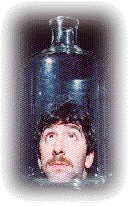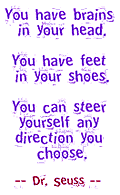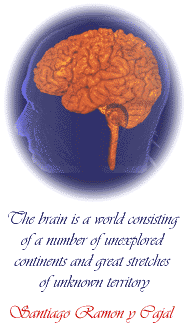Neuroscience For Kids
Another Day, Another Neuron
 The lights are low. Electronic equipment hums. A loud speaker pops and
crackles. Green lights flash across a monitor as a recording tape rolls.
An electrode is lowered. Ah...another day studying the brain . Not all
scientists who study the brain and the rest of the nervous system
(neuroscientists) work in these conditions...some work in the jungles of
the Amazon looking for new plants that may hold the cure for neurological
disorders; others work in the clinics of medical centers helping people
stricken with neurological disease; still others work in laboratories
examining microscopic sections of the brain or the studying the behavior
of man and other animals.
The lights are low. Electronic equipment hums. A loud speaker pops and
crackles. Green lights flash across a monitor as a recording tape rolls.
An electrode is lowered. Ah...another day studying the brain . Not all
scientists who study the brain and the rest of the nervous system
(neuroscientists) work in these conditions...some work in the jungles of
the Amazon looking for new plants that may hold the cure for neurological
disorders; others work in the clinics of medical centers helping people
stricken with neurological disease; still others work in laboratories
examining microscopic sections of the brain or the studying the behavior
of man and other animals.
So what does it take to study that 1.4 kilogram (3 pound) mass of tissue in our heads we call the brain? What does a neuroscientist actually do? Can the part of our anatomy that makes us who we are really be studied?
To Become a Neuroscientist
 When you ask a child, "What do you want to be when you grow
up?" many will answer, "I want to be a Teacher" or "I want to be a
Fireman" or "I want to be a Pilot" - I doubt any will say "I want to be a
Neuroscientist." Yet many people do pursue careers studying the nervous
system. In fact, the Society for
Neuroscience, an international organization of scientists who study
the nervous system, has over 38,000 members!
When you ask a child, "What do you want to be when you grow
up?" many will answer, "I want to be a Teacher" or "I want to be a
Fireman" or "I want to be a Pilot" - I doubt any will say "I want to be a
Neuroscientist." Yet many people do pursue careers studying the nervous
system. In fact, the Society for
Neuroscience, an international organization of scientists who study
the nervous system, has over 38,000 members!
To start on the road to becoming a neuroscientist - any scientist for that matter - first and most importantly, you must get an education. Study hard in school and go to college. Once in college, you do not need to take neuroscience classes immediately. Shop around - take classes in a variety of departments and follow your interests. Neuroscientists come from many different disciplines including psychology, zoology, physics, anthropology, biology, chemistry, physiology, and philosophy. A diverse educational background will provide the most important skill of all: how to ask questions.
As an undergraduate, you may have a chance to test the waters of research by working in a neuroscience lab. Ask around - neuroscientists are always looking for cheap labor. You could even make a little money. As a volunteer research subject, you could also make a little money. Just strap on the electrodes and ...Don't worry - all experiments, even those on students, MUST be approved by a university human subjects committee to determine that they are safe.
After finishing at the university with your Bachelor of Science or Bachelor of Arts degree, you are now ready for the next step - graduate school or medical school or dental school. Some people go to graduate school for their Ph.D. and a health profession school such as medical, dental or nursing school. You have a wide range of departments from which to select your area of study. Many universities have separate neuroscience departments, but psychology, physiology, pharmacology, and biology departments also offer coursework and laboratories that study the nervous system. Do you want to study how drugs affect the brain? Why do we sleep? What causes and what are the treatments for Parkinson's disease, Alzheimer's disease, stroke, schizophrenia? What about pain, memory, stress, emotion, consciousness? The list is endless. It is important that you pick a graduate program with people who are doing what you want to do. Nevertheless, it is common for students who are pursuing one area of neuroscience to become interested in another area and switch labs. As long as you use some tact and common courtesies with your advisor, changing labs should not be a problem.
Many graduate schools will assist you financially with stipends in the form of research and teaching assistantships. Research assistants typically perform experiments in a laboratory under the guidance of a senior researchers. Teaching assistants help instructors with classroom duties such as grading papers, leading discussion sections and even lecturing students. These are not high paying positions, but they are wonderful training ground for the future.
So you have your Ph.D.and/or M.D. and D.D.S.? Now what? Many people further their training with a "postdoctoral" fellowship. A "post-doc" goes to a laboratory where he or she can learn new techniques or explore a new area of neuroscience. Your time as a post-doc is free from the worries of grant writing and teaching...you are in the lab to do research. After your post-doctoral fellowship, it is time to get a "real job." Here are just some places that offer employment for neuroscientists:
- Government (for example, in laboratories at the National Institutes of Health) - These positions usually do not involve traditional teaching responsibilities.
- University (as a researcher or teacher) - At the university it is sometimes difficult to balance research and teaching duties. However, the university environment, surrounded by students interested in learning, is exciting.
- Industry (for example in biotechnology, pharmaceutical or medical instruments companies) - Often paying higher salaries than government or university jobs, private industry offers the chance to research and develop new products for the marketplace without the pressure of teaching responsibilities.
- Hospital or Medical Center (as a clinician and/or researcher) - Working in a medical center is an ideal place to study neurological disorders in patients.

Brains from Several Different Species
(Image
courtesy of the Mammalian Brain
Collection at the University of Wisconsin, Michigan State
University and National Museum of Health and Medicine)
Although employment opportunities in some major cities are sparse, there are jobs for neuroscientists - you just have to know where to look.
"Neuroscientist" is actually a general word that describes someone who studies the nervous system. Many neuroscientists "wear several hats." For example, a neurosurgeon may also have a Ph.D. in physiology. He or she may work in the operating room but also have time to perform experiments. There are many career paths that neuroscientists can take:
| Neuroanatomist | studies the structure (anatomy) of the nervous system |
| Neurobiologist | studies the biology of the nervous system |
| Neurochemist | studies the chemistry (for example, neurotransmitters) of the nervous system |
| Neurological Surgeon | a physician who performs surgery on the nervous system |
| Neurologist | a physician who diagnoses and treats disorders of the nervous system |
| Neuropathologist | studies diseases of the nervous system |
| Neuropharmacologist | studies the action of drugs on the nervous system and/or behavior |
| Neuropsychologist | studies brain-behavior relationships (especially cognitive functions) in humans |
| Neurophysiologist | studies the physiology of the nervous system. |
| Physiological Psychologist (Psychobiologist or Biological Psychologist) |
studies the neural basis of behavior |
| Psychiatrist | a physician who diagnoses and treats mental disorders |
| Psychophysicist | studies the relationships between environmental stimuli (for example, light, sound, or heat) and the resulting sensations and perceptions that they produce |
A Day in the Life of a Neuroscientist
You have finished your training, you have a nice job. What does a neuroscientist really do? Like most professions, the job of a neuroscientist requires a multitude of talents. In addition to performing experiments in their area of expertise, neuroscientists must be:
- writers (to publish manuscripts and write grant applications)
- accountants (to balance laboratory expenses)
- fund raisers (to support the laboratory financially)
- electricians, carpenters and plumbers (to repair minor problems with equipment or build new instruments)
- teachers (to lecture large audiences and classes or talk one-on-one with students)
- travel agents (to get to meetings around the country and world)
- artists (to create graphics and illustrations of results from experiments)
- photographers (to document your work and prepare manuscripts)
- counselors (to advise students)
- editors (to critique their own work and that of others)
Neuroscientists in charge of their own labs are also head custodian and chief bottle washers.
Challenges for the Future
Because of many technological advances, neuroscience has made great strides in recent years. There is the patch clamp to listen to ion channels; the electron microscope to see inside neurons; single unit techniques to record electrical activity from inside and outside of individual neurons; positron emission tomography to study brain function; magnetic resonance imaging to see inside the living brain. Yet even with all these inventions, there is still so much to learn about the brain and the rest of the nervous system. The next century holds many exciting challenges for current and future neuroscientists. Here are only a few of the possible questions that face neuroscientists in laboratories and clinics around the world:

- What are the methods for early detection of neurological disorders such as Parkinson's disease and Alzheimer's disease and for mental disorders such as schizophrenia and depression? What are the causes of these illnesses? What are the cures?
- How can we help nerves regenerate? Can we cure spinal cord injuries? Can we transplant or replace parts of the brain?
- What causes chronic pain? What is the best way to treat pain? How can we tap into our endogenous pain inhibitory system?
- What are the mechanisms of addiction? Are there better ways to treat addictions?
- How are memories formed, stored and lost?
- What are better ways to image the living brain?
- What is the neurological basis of emotions such as anger, happiness and sadness?
- What are the differences in the brains of men and women and what do these differences mean?
- How does experience and learning affect the brain and how can we use this information to improve our daily lives?
- What are the neurological mechanisms of "alternative medicine" treatments such as acupuncture, herbal therapy and hypnosis and how can these methods be used to treat nervous system disorders?
- Why do we sleep and how can we shift our internal body clocks?
- What is consciousness?
Neuroscientists are studying these and many other questions about the brain right now. With increased effort, the answers to these questions are in the near future. Perhaps you would like to help?
More information:
- A Career in Neuroscience: A Game of "Survivor?"
- Becoming a scientist - Interviews with biomedical researchers (Howard Hughes Medical Institute)
- Blue brain Image courtesy of Dr. Robert C. Coghill
Copyright © 1996-2021, Eric H. Chudler All Rights Reserved.
